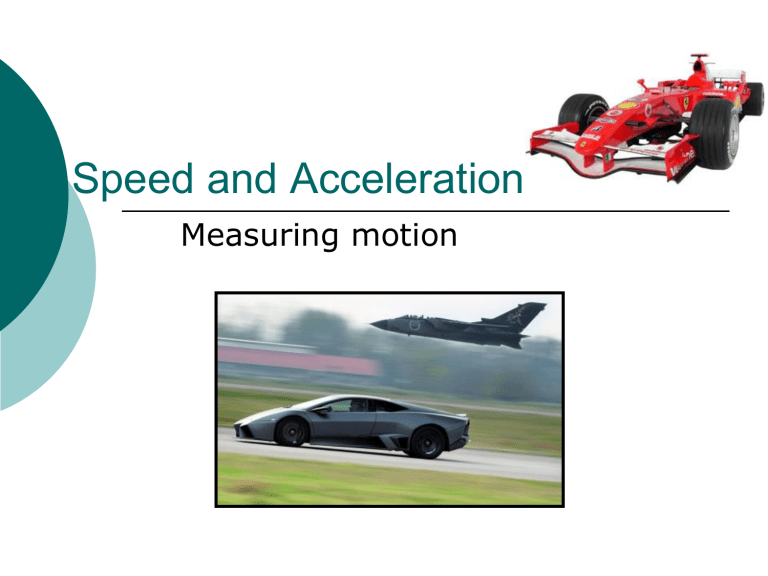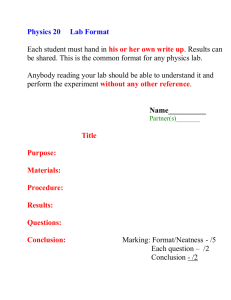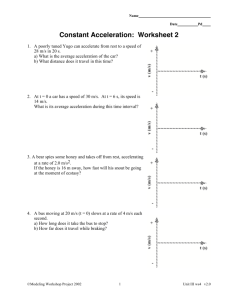Speed and Acceleration
advertisement

Speed and Acceleration Measuring motion Measuring Distance Meter – international unit for measuring distance. 1 mm = 50 m Calculating Speed Speed (S) = distance traveled (d) / the amount of time it took (t). S = d/t Units for speed Depends, but will always be a distance unit / a time unit Ex. Cars: mi./h Jets: km/h Snails: cm/s Falling objects: m/s Calculating speed S = d/t If I travel 100 kilometer in one hour then I have a speed of… 100 km/h If I travel 1 meter in 1 second then I have a speed of…. 1 m/s Average speed Speed is usually NOT CONSTANT Ex. Cars stop and go regularly Runners go slower uphill than downhill Average speed = total distance traveled/total time it took. Calculating Average Speed It took me 1 hour to go 40 km on the highway. Then it took me 2 more hours to go 20 km using the streets. Total Distance: Total Time: 40 km + 20 km = 60 km 1 h + 2 h = 3 hr Ave. Speed: total d/total t = 60 km/3 h = 20 km/h Total _ Dist . Ave. _ Speed Total _ time Question I travelled 25 km in 10 minutes. How many meters have I travelled? A) 25000 m B) .0112 m C) .025 m D) 2.5 m 25 km * 1000m/km = 25000 m Question I ran 1000 m in 3 minutes. Then ran another 1000 m uphill in 7 minutes. What is my average speed? A) 100 m/min TotalDist. = 1000 m + 1000 m = 2000 m B) 2000 m/min TotalTime 3 min + 7 min = 10 min C) 10=m/min D) 200 m/min Ave speed = total dist/total time = E) 20 m/min 2000m/10 min = 200 m/min = D Velocity Velocity – the SPEED and DIRECTION of an object. Example: An airplane moving North at 500 mph A missile moving towards you at 200 m/s Question What is the difference between speed and velocity? Speed is just distance/time. Velocity includes direction as well. Graphing Speed: Distance vs. Time Graphs Denver Phoenix Graphing Speed: Distance vs. Time Graphs Speed = Slope = Rise/ Rise Graphing Speed: Distance vs. Time Graphs Speed = Slope = Rise/ Rise=? 600 km 3h Graphing Speed: Distance vs. Time Graphs Speed = Slope = Rise/ Rise=? 600 m 3 minutes Rise/ Distance (km) Different Slopes 8 7 6 5 4 3 2 1 0 Slope = Rise/Run = 1 km/1 hr = 1 km/hr Slope = Rise/Run = 0 km/1 hr = 0 km/hr Rise = 2 km Rise = 0 km Run = 1 hr Run = 1 hr Slope = Rise/Run = 2 km/1 hr = 2 km/hr Rise = 1 km Run = 1 hr 1 2 3 4 Time (hr) 5 6 7 Question Below=isTotal a distance vs. time graph ofkm/6 hr Average Speed distance/Total time = 12 my position =during a race. What was 2 km/hr my AVERAGE speed for the entire race? 14 Distance (km) 12 10 8 Rise = 12 km 6 4 2 0 0 1 2 3 Time Run = (hr) 6 hr 4 5 6 Question What does the slope of a distance vs. time graph show you about the motion of an object? It tells you the SPEED Question Below is a distance vs. time graph for 3 runners. Who is the fastest? 7 Distance (mi.) 6 5 Bob Jane Leroy 4 3 2 1 0 0 1 2 3 4 5 6 35 Time (h) Leroy is the fastest. He completed the race in 3 hours Acceleration Acceleration = speeding up Acceleration – the rate at which velocity changes Can be an: Increase in speed Decrease in speed Change in direction Types of acceleration Increasing speed Decreasing speed Example: Car speeds up at green light screeeeech Example: Car slows down at stop light Changing Direction Example: Car takes turn (can be at constant speed) Question How can a car be accelerating if its speed is a constant 65 km/h? If it is changing directions it is accelerating Calculating Acceleration If an object is moving in a straight line Final _ speed Initial _ Speed Acceleration Time Units of acceleration: m/s2 Calculating Acceleration Final _ Speed Initial _ Speed Acceleration Time 16m / s 0m / s 4s 4m / s 2 0s 0 m/s 1s 4 m/s 2s 8 m/s 3s 12 m/s 4s 16 m/s Question A skydiver accelerates from 20 m/s to 40 m/s in 2 seconds. What is the skydiver’s average acceleration? Final _ speed Initial _ speed Accel Time 40m / s 20m / s 20m / s 2s 2s 2 10m / s Graphing Acceleration Can use 2 kinds of graphs Speed vs. time Distance vs. time Graphing Acceleration: Speed vs. Time Graphs 14 Speed (m/s) 12 10 8 6 4 2 0 0 1 2 3 4 5 6 Time (s) 1)Speed is increasing with time = accelerating 2)Line is straight = acceleration is constant Graphing Acceleration: Speed vs. Time Graphs 14 Speed (m/s) 12 10 8 Rise = 4 m/s 6 4 Run = 2 s 2 0 0 1 2 3 4 5 Time (s) 1)In Speed vs. Time graphs: Acceleration = Rise/Run = 4 m/s ÷ 2 s = 2 m/s2 6 Graphing Acceleration: Distance vs. Time Graphs 35 Distance (m) 30 25 20 15 10 5 0 0 1 2 3 4 5 Time (s) 1)On Distance vs. Time graphs a curved line means the object is accelerating. 2)Curved line also means your speed is increasing. Remember slope = speed. Question 14 Speed (m/s) 12 Run = 3 s 10 8 Rise = -6 m/s 6 4 2 0 0 1 2 3 4 5 6 Time (s) Above is a graph showing the speed of a car over time. 1) How is the speed of the car changing (speeding up, Slowing down, or staying the same)? 2) What is this car’s acceleration? 1) The car is slowing down 2) Acceleration = rise/run = -6m/s ÷3s = -2 m/s2 Question: 35 Distance (m) 30 25 20 15 10 5 0 0 1 2 3 4 5 Time (s) a objects that are The black and red lines represent accelerating. Black is going a greater distance each second, so it must be speeding up. Red is going less each second, so must1)Which be slowingline downrepresents an object that is Remember: in distance vs. time graphs: accelerating? curved line = accelerating, flat line = constant speed Question: Hard one Distance (m) Speed (m/s) 14 45 40 12 35 10 30 258 206 15 4 10 52 00 0 0 11 22 33 4 4 5 5 6 6 Time Time (s)(s) Above is a graph showing the speed of a car over time. 1)What would a distance vs. time graph for this look like?



